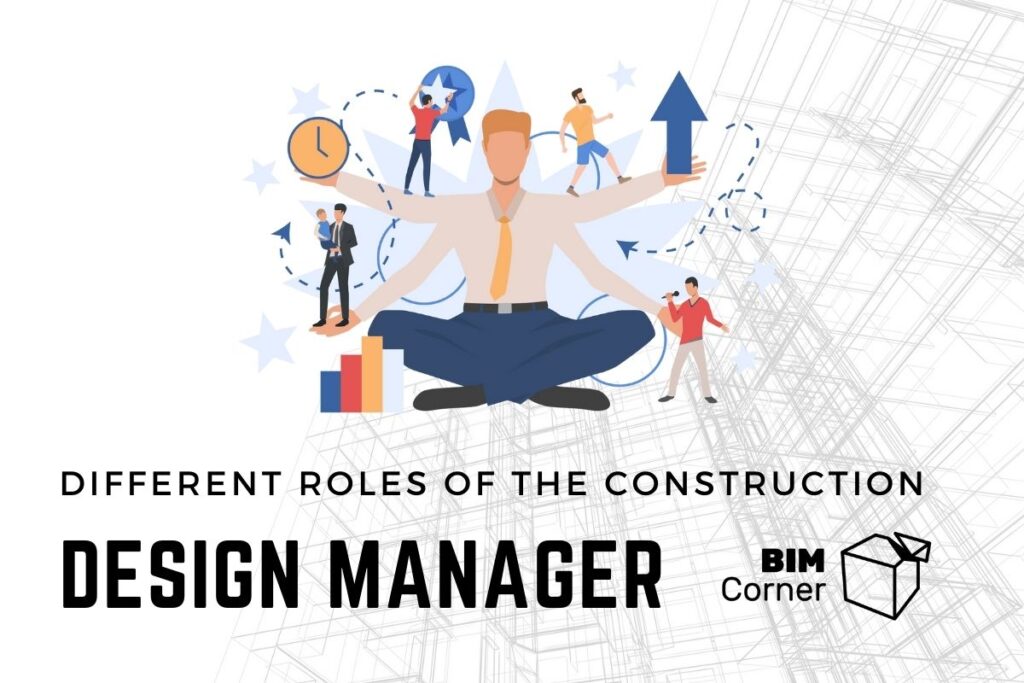The job needs to be done – how many times have we heard this sentence? It is often spoken in a situation where we do not have enough time or resources, and yet a given stage of the project needs to be completed. It can be both the delivery of the design documentation or concreting of the load-bearing walls. Often, also in such a case, it is required to take over more duties or work than it results from our position. For example, a BIM coordinator corrects discipline models himself, and a foreman puts on gloves and places the reinforcement. And the design manager? What different roles and responsibilities can he take on the project?
In the previous post What is design management? Managing design in practice, I started the topic of the different roles of a design manager. It is influenced by the type of project and its phase, the way it is carried out, and the type of company or organization.
What does this mean in practice? When working as a design manager in a design company, we may have completely different responsibilities than having the same position as the investor or contractor.
This is the second article in a series of design management. You can read the first article HERE. Did you like this post and should we continue the topic of design management? Or maybe there is some other topic that you would like to read about on our blog? Leave your opinion in the comment below the article!
Table of Contents
How many design managers are there on a project?
Of course, it depends on the type of project and contract, the number of parties involved, the internal practice of companies … and many other things 🙂 We could talk a lot about the theory and various dependencies, but traditionally on our blog we will focus on practice! We will consider the most popular models of contract organization, giving real-life examples.
Answering the question in the title of the paragraph: from my own experience, I can say that I took part in projects where there were even four or more people holding this position. And in others where the number of design managers was equal to zero 🙂
Design - bid - build contract
Let’s look at the organizations taking part in the project carried out using the traditional method (design – bid / tender – build / construction). Please note that these are simplified diagrams that can actually be much more detailed.
The client – with the orange background color – has a design office underneath him (blue background) and is responsible for the preparation of design documentation for contractors (green and purple background). Suppose we have one general contractor for this part of the project (green background).
Here we see a design manager from the client who has a very high responsibility. This position may also be a design coordinator or a planning engineer, for example. These functions can also be divided into the project manager and the rest of the engineering staff. The design manager has the following duties in this case:
- Coordination and work with the design office or a group of design and / or architectural offices.
- Ensuring that the designer’s work is delivered on time, in the ordered quality, and within the budget.
- Consideration and finding optimal design solutions.
- Define the relevant permits and organize them (or transfer this responsibility to someone else).
- Including health and safety issues and environmental protection in the project.
- Participation in the selection of the general contractor and providing him with the design documentation.
- Responding to technical inquiries from the main contractor. Some questions can be answered by the design manager himself, and some by a design office, going through the client.
In the contract carried out in a traditional way, we also have a design manager in a design or architectural office. Here, again, it all depends on how ‘split’ the design contract is. In some countries, the position of an architectural office is very strong and it is the chief architect who can coordinate the work of an office or design offices on behalf of the clint. On the other hand, in other contracts, we can deal with a situation where a design office and the main designer conducts the entire design process and selects, if necessary, an external architectural office or other offices with specific expertise. We mainly have these two situations: the client has a contract with one design company that has its subcontractors, or the client himself selects various companies whose work is coordinated by him.
So we have a design manager in a design office, whose position can also be defined as, for example: chief designer, lead designer, chief architect, design lead, manager of the design team, or design coordinator. The most important tasks of such a person are:
- Being the main point of contact between the design office and the client.
- Preparation and presentation of reports on design work to the client (for example weekly or monthly).
- Agreeing on design solutions with the client.
- Clarifying technical inquiries – both between designers and the client, as well as between the general contractor and the client.
- Supervision so that the design work is of adequate quality. It concerns the internal quality system of the office and its documentation.
- Ensuring that the project documentation is delivered on time, in the ordered quality, and within the budget.
- Informing the client in the event of possible delays or other risks related to the design work.
Design and build contract
In the case of a contract executed in the design and build formula, the position of a design manager usually appears for all project participants.
It is, in addition to the client’s design manager, the design manager in the main contractor’s organization (green background), who bears a very large responsibility when it comes to coordination. Under him, he has a design manager in the design office (blue background), as well as at suppliers and subcontractors. In addition, he must ensure the coordination of design works with possible neighboring contracts. For example, if it is a road section divided into several contracts, it may be necessary to select similar technical solutions along its entire length. Additionally, in such a case it is also required to define the interface (the division of responsibilities) at the border of the different projects.
All this while ensuring that the interests of your own company and the construction site are taken care of and that the construction and project managers and rest of the staff are satisfied with the quality and designed solutions. As well as the delivery time of the documentation. Not to mention that it should be within the planned budget 🙂
Naturally, the main difference between a contract performed using the traditional method and the design and build is the design responsibility which now rests on the main contractor. Usually (although it also depends on the type of contract), the contractor receives an overview design documentation prepared by the client during the tender. Based on it, together with the technical descriptions and general terms and conditions of the contract, the contractor must decide to what extent to involve the design office in the initial, tendering phase. This is one of the contractor’s design manager’s responsibilities. In addition, there are, among others:
- Coordination between designers and own staff (e.g. cost estimators and project and construction manager) in order to prepare the basis for the cost estimate.
- Searching for optimization and agreeing on design solutions within the organization.
- Clarifying technical inquiries – both those between designers and the contractor, as well as the general contractor and the client.
- Supervision so that the design work is of adequate quality. If necessary, control of the internal quality system of the design office and how it is documented.
- Ensuring that the project documentation is delivered on time, in the ordered quality, and within the assumed budget.
- The decision on the degree of use of the BIM methodology on the project. Preparation of a BIM strategy / vision and basic documents such as BEP (you can read about the BIM Execution Plan here).
The above-mentioned are just some of the responsibilities of a design manager in a contractor company during the tendering phase of a design and build contract. After winning the tender, the design manager takes over additional responsibilities in connection with the need to execute the detailed design, such as:
- Implement a BIM strategy on the project and decide to what extent the models will be used during construction. What kind of information do they need to contain? Is it necessary (for the client or for the production needs) to create traditional 2D drawings? It is also related to the establishment of information exchange systems and processes and the support of the BIM manager, e.g. when establishing the CDE platform, requirements for designers, or creating a BEP / BIM manual.
- Control of what has been designed against what is to be built (“buildability”), also by involving the contractor’s representatives in the design process.
- Signing and supervising a contract with a designer, including a detailed schedule for the delivery of project documentation, taking into account milestones.
- Coordination between multiple project participants, i.e. the client, designer, subcontractors, suppliers.
- Ensuring that the design process is being done within the assumed time, quality and budget.
- Checking whether the conditions and requirements of the contract, standards, specifications, etc. are met during the design process.
- Searching for opportunities to optimize design solutions, together with designers, subcontractors, suppliers, and staff who will carry out a given project.
When it comes to a design manager in a design office, it can be said that he will have practically the same duties as before – except that his client is now a contractor. In the case of a design and build contract, however, the designers must also change their mindset. The current client – the contractor – is more demanding and is constantly looking for optimization or simply doing something in an easier, faster and / or cheaper way. A design manager in a design office must therefore be open to discussions and provide information on the consequences of possible changes in a clear and precise way.
Practical example: Due to the use of a specific type of formwork, the contractor wishes to change the wall thickness from 500 mm to 400 mm. By the way, he would like to save the amount of concrete. Let’s assume that it is possible from a structural point of view, but it has various consequences: static recalculation of the structure (additional working hours), more reinforcement (material), and revision of the model or drawings (subsequent working hours of the designer). In addition, there may be external consequences of introducing possible changes, such as the need for independent second-time control and approval of a given part of the project (time). Only knowing these consequences and the risks associated with them, the contractor can decide whether he wants to introduce optimization of the structure, or he will look for a different solution. As during the entire project, communication and cooperation are very important in this case.
Summary
Perhaps when you started reading about the position of ‘design manager’ in the first article in our series, this function may have seemed out of touch with reality. Therefore, in this post, we looked at the practical duties and placement of the design manager on the project depending on the type of contract and organization. The examples given are based on experience from real projects. However, remember that each one is specific and how they are carried out may differ depending on the organization and country in which we work. That is why it is so important to understand the general idea of managing the design process – after all, it does not matter if these duties are performed by the person who has the ‘design manager’ in the job title, or not. Because, as we could read in the introduction to this article – the job has to be done 🙂 And the design management is needed wherever the design process takes place!
And you, dear reader, what do you think about the design management?
What are your experiences with this subject?
Is there a design manager in your organization, or are the responsibilities associated with that position distributed among many different people?
We are curious about your opinions and comments!
This is the second article in a series of design management. You can read the first article HERE. Did you like this post and should we continue the topic of design management? Or maybe there is some other topic that you would like to read about on our blog? Leave your opinion in the comment below the article!











I have gone through the blog post and I must admit it is very informative. I liked the writing style too. Keep up the good work and share more contents. Cheers!
Thank you for the feedback! Is there anything specific that you would like to read in connection to design management?
Thank you for information. In fact, there are now great tools for automating the workflow and controlling construction projects, so that many managers can work in one place, for a more efficient result.
Thank you for the comment!
I always look forward to reading your articles. You obviously put a lot of effort into this post, and I appreciate that.
Hello,
Thank you for the message! This type of positive feedback keeps us doing what we do – sharing the knowledge and experience on the blog, for free:-)
Are there any specific topics that you would like to read about in the future?
Best regards,
Konrad N.